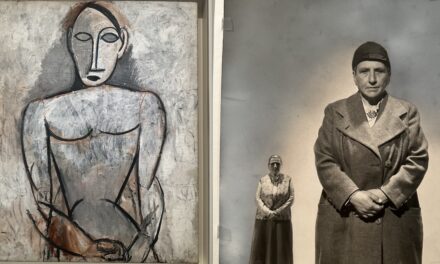Disappointments always
There are always disappointments at auction: idolized artists whose works sell for lower prices than expected, or even go unsold. It’s this element of uncertainty that lends everything its charm and suspense at the major sales at auction. Over nearly two weeks from 11 to 19 May, New York has presented a mass of artworks from the late 19th, 20th and 21st centuries at Christie’s, Sotheby’s and Phillips. At the same time a fair with a classic offering has been taking place, the New York Tefaf, and a fair featuring very contemporary art, Frieze New York. This is to say that the opportunities for artistic acquisitions are proliferating across the American megacity.
The icon of the season
If we had to choose the icon of the season, there would be talk of the large-scale painting by Jean-Michel Basquiat across three panels with an estimate of 45 million, which sold for 67.1 million dollars at Christie’s (see the report here). At a time of great political, economic and even geostrategic uncertainty, the auction results have been broadly satisfying, with 81% to 100% of lots sold following the shows.
Minimizing failures
The auction houses, well aware of their influence on the global art market as a whole, have wisely staged them to minimize the risks of failure. One of the ways this is done is through a system of guarantees (the firm itself or a third party agrees to pay a sum that is given to the seller regardless of the outcome of the auction) to avoid – or reduce – any nasty surprises. However, we note in May 2023, according to several insiders, that there is not only a widespread drop in demand (fewer prospective buyers for each lot) but also a more tempered enthusiasm in comparison with previous seasons.
Less euphoria
The relatively less euphoric atmosphere was also perceptible due to the fact that Sotheby’s, for example, withdrew five lots from their modern art sale on 16 May before the auctions took place, most likely due to a lack of bidders. At the dispersal of a remarkable ensemble belonging to the late Boston collector Gerald Fineberg on 17 May by Christie’s, nine lots out of the 65 presented were sold for sums that were considerably less than the low estimates.
The market is showing more significant corrections than usual for certain well established names. Here are three case studies:
Yayoi Kusama (born in 1929)
The Japanese contemporary art superstar, who for many years has been living as a voluntary inpatient at an asylum, is, as was once said about Andy Warhol in his time and without value judgment, “a commercial artist”. She likes success and her multiplied presence on the international art scene has been enabled through her powerful Western galleries, Zwirner and Victoria Miro. According to the Artprice database, in 2022 the total number of Kusama’s works that changed hands at auction amounted to 162 million dollars. It is in Hong Kong that her pieces are presented for the most part. Clearly her popular support has been consolidated by a sprawling promotional strategy of which she was the subject since early 2023 via the Louis Vuitton fashion house, for whom she has customized numerous objects, bags etc…
A vocabulary of obsession

Yayoi Kusama sold in Hong Kong
But what is often forgotten is that her success is due to the establishment of a vocabulary of repetition and obsession that has haunted her since childhood. From 1959 she has created patterns composed of nets and dots. She lived in New York, evolving in avant-garde circles and creating psychedelic performances that often addressed themes of sexuality. This is where she developed the signature style she would go on to reiterate over and over.
Relief paintings from 1965
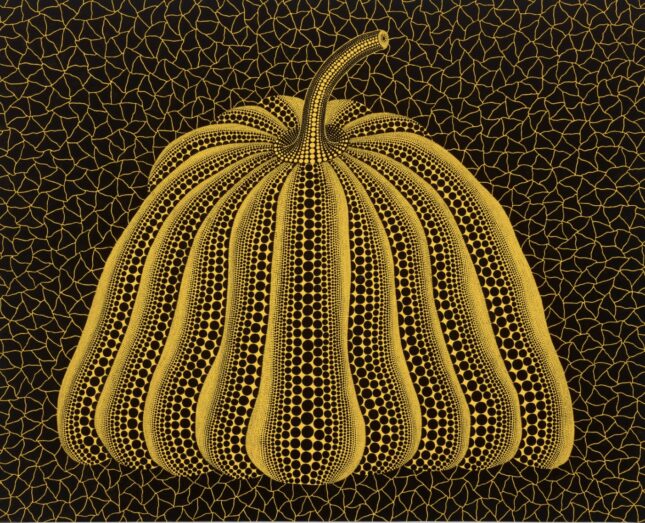
Yayoi Kusama sold in New York
On 17 May 2023 Phillips sold two of her major and rare relief-paintings from 1965, made using a kind of accumulation of large phallic beans made of fabric, decorated with stripes and dots. Contrary to expectations, they sold in the lower range of estimates for 2.7 and 3.2 million dollars. However, in 2021, again at Phillips, an extraordinary canvas from 1959 made from countless white dots on a white background sold for the record price of 8.8 million dollars.
Famous Pumpkins
In contrast, Kusama’s famous pumpkins, which are also the symbol of the Japanese museum island, Naoshima, represent – despite their ultra-repetitive character – safe bets for the market. A version painted in 2011 was sold for 5.7 million dollars in Hong Kong at Sotheby’s on 5 April 2023, and another from 1993 on 15 May followed in New York for 4.8 million. The record for this subject – 8 million dollars – is held by a “portrait” of a pumpkin painted in 2013 and sold in 2021. Art history and the art market don’t always go hand in hand.
Christopher Wool (born in 1955)
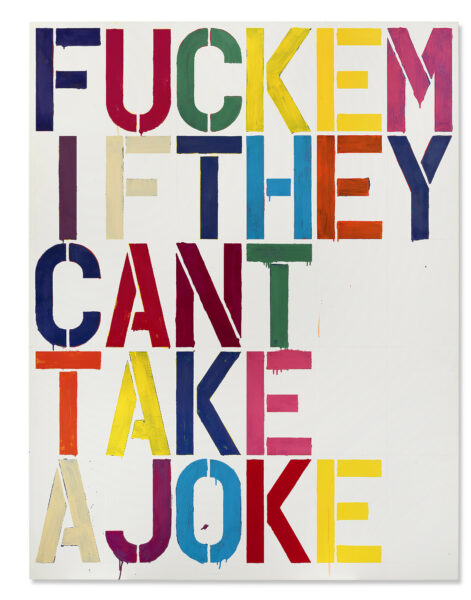
Christopher Wool
Christopher Wool is an American conceptual artist who is quite reserved and low-profile. He works with the idea of motif, gesture and repetition in painting. He has produced, among other things, a series of works using striking words, depicted on a large scale on canvas.
Speculation
He was the subject, in spite of himself, of intense speculation during the 2010s, most likely due to the immediately recognizable character of his work. In 2015 a painting from 1990, “RIOT”, was auctioned for 26.5 million dollars, the record price for the artist. Six paintings by Wool were presented this season in New York, selling for up to 8.4 million dollars for one 1993 work at Christie’s.
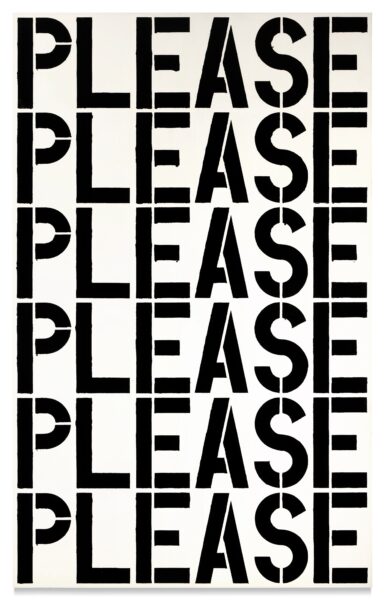
Christopher Wool
FUCKEMIFTHEYCANTTAKEAJOKE
This sum, although it may seem like a lot in absolute terms, seems disappointing for those in the know, in light of its catalogue estimate of 15 million dollars. Made in 1993, it is marked with the inscription: “FUCKEMIFTHEYCANTTAKEAJOKE”. Another painting, covered six times with the word PLEASE, went for 8.3 million dollars at Sotheby’s. According to the Artnet website it belonged to the creator of the Cirque du Soleil, Guy Laliberté, who acquired it in 2017 for 17.1 million dollars. The latter therefore lost nearly 8 million dollars in this transaction. Christopher Wool has left the wave of speculation that has long driven his market.
Jeff Koons

Jeff Koons
Three works by Jeff Koons were presented this season. Among them is a painting from the “gazing balls” series, which did not sell on 15 May at Christie’s. Dating from 2015-2019, it had an estimate of 800,000 dollars. It copies a painting by Velazquez depicting the infanta of the King of Spain, inside which the American artist has introduced a ball of blue metal in relief, the kind you would find to decorate gardens and deter birds in the region of York, Pennsylvania, where he was born. We have to go back to 2021 to find another painting from the same series at auction, the reproduction of a Titian, “Mar, Venus and Cupid”, which sold for 1.2 million dollars.
Children’s story
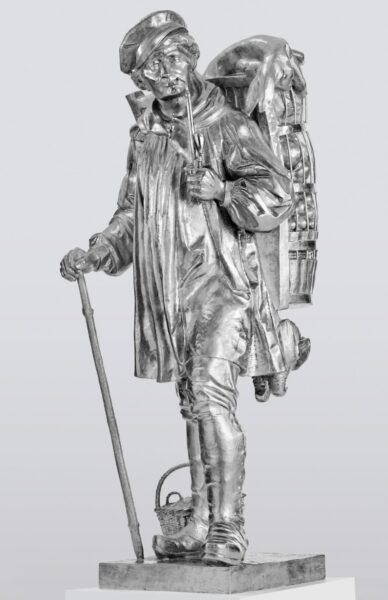
Jeff Koons
Generally speaking, we might think that the paintings by the American artist are less sought after than his sculptures. However, on 17 May 2023 at Christie’s, a “historic” sculpture by the artist, in stainless steel, measuring 180cm tall, depicting a typical 19th-century figure, a travelling merchant (Kiepenkerl), referencing a children’s story, was sold for 1.9 million dollars against an estimate of 3 million dollars.
History of readymade
To understand the significance of this sizeable object dated from 1987, we can read the commentary of one of his first dealers, Jeffrey Deitch, who wrote in the catalogue for his retrospective at the Whitney museum in 2014: “One of Koons’s artistic ambitions has been to add to the history of the readymade. The challenging fabrication of his Kiepenkerl sculpture in 1987 gave him the idea of using traditional craftsmen as ‘human readymades’”. In 2014 another copy of the same work was sold for 4 million dollars and another again in 2008 for 6.2 million dollars. Perhaps contemporary art fans are starting to forget the meaning behind Koons’s early work, which is more sophisticated than it first seems.
Support independent news on art.
Your contribution : Make a monthly commitment to support JB Reports or a one off contribution as and when you feel like it. Choose the option that suits you best.
Need to cancel a recurring donation? Please go here.
The donation is considered to be a subscription for a fee set by the donor and for a duration also set by the donor.


